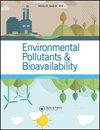Removal of aqueous ammonium by biochars derived from agricultural residuals at different pyrolysis temperatures
Q3 Chemical Engineering
引用次数: 69
Abstract
Abstract Water contamination by ammonium ions presents huge risks to the ecosystems. This work evaluated the potential of biochar as an alternative adsorbent to remove ammonium from aqueous solutions. Nine types of biochars were converted from three types of agricultural residuals at three pyrolysis temperatures. Batch sorption experiment showed that all the biochars effectively removed ammonium ions from water. The biochars produced at low pyrolysis temperatures, however, showed higher sorption of ammonium. The low-temperature biochars showed relatively fast sorption kinetics of ammonium, which reached equilibrium around 10 h. Sorption isotherms showed that the low-temperature biochars had high sorption capacities to the ammonium, and the Langmuir maximum capacities were all higher than 200 mg/g. Batch sorption experiments also showed the sorption of ammonium onto the biochar was affected by pH and temperature, but not by ionic strength. The biochar showed good sorption ability to ammonium in aqueous solutions under all of the tested conditions. Findings from this work indicated that biochar could be used as an alternative adsorbent for the treatment of ammonium in water.不同热解温度下农业渣滓生物炭脱除铵盐的研究
摘要水体铵离子污染给生态系统带来巨大风险。这项工作评估了生物炭作为一种替代吸附剂从水溶液中去除铵的潜力。在三种热解温度下,由三种农业渣滓转化成九种生物炭。间歇式吸附实验表明,所有生物炭都能有效去除水中的铵离子。低热解温度下生产的生物炭对铵的吸附性较高。低温生物炭对铵的吸附动力学较快,在10 h左右达到平衡。吸附等温线表明,低温生物炭对铵具有较高的吸附能力,Langmuir最大吸附量均大于200 mg/g。间歇式吸附实验还表明,生物炭对铵的吸附受pH和温度的影响,但不受离子强度的影响。在所有测试条件下,生物炭对水溶液中铵的吸附性能都很好。研究结果表明,生物炭可作为处理水中铵的吸附剂。
本文章由计算机程序翻译,如有差异,请以英文原文为准。
求助全文
约1分钟内获得全文
求助全文
来源期刊
CiteScore
1.62
自引率
0.00%
发文量
0
审稿时长
1 months
期刊介绍:
Chemical Speciation & Bioavailability ( CS&B) is a scholarly, peer-reviewed forum for insights on the chemical aspects of occurrence, distribution, transport, transformation, transfer, fate, and effects of substances in the environment and biota, and their impacts on the uptake of the substances by living organisms. Substances of interests include both beneficial and toxic ones, especially nutrients, heavy metals, persistent organic pollutants, and emerging contaminants, such as engineered nanomaterials, as well as pharmaceuticals and personal-care products as pollutants. It is the aim of this Journal to develop an international community of experienced colleagues to promote the research, discussion, review, and spread of information on chemical speciation and bioavailability, which is a topic of interest to researchers in many disciplines, including environmental, chemical, biological, food, medical, toxicology, and health sciences.
Key themes in the scope of the Journal include, but are not limited to, the following “6Ms”:
Methods for speciation analysis and the evaluation of bioavailability, especially the development, validation, and application of novel methods and techniques.
Media that sustain the processes of release, distribution, transformation, and transfer of chemical speciation; of particular interest are emerging contaminants, such as engineered nanomaterials, pharmaceuticals, and personal-care products.
Mobility of substance species in environment and biota, either spatially or temporally.
Matters that influence the chemical speciation and bioavailability, mainly environmentally relevant conditions.
Mechanisms that govern the transport, transformation, transfer, and fate of chemical speciation in the environment, and the biouptake of substances.
Models for the simulation of chemical speciation and bioavailability, and for the prediction of toxicity.
Chemical Speciation & Bioavailability is a fully open access journal. This means all submitted articles will, if accepted, be available for anyone to read, anywhere, at any time. immediately on publication. There are no charges for submission to this journal.

 求助内容:
求助内容: 应助结果提醒方式:
应助结果提醒方式:


